fuel KIA Rondo 2008 2.G Owner's Guide
[x] Cancel search | Manufacturer: KIA, Model Year: 2008, Model line: Rondo, Model: KIA Rondo 2008 2.GPages: 341, PDF Size: 6.23 MB
Page 320 of 341
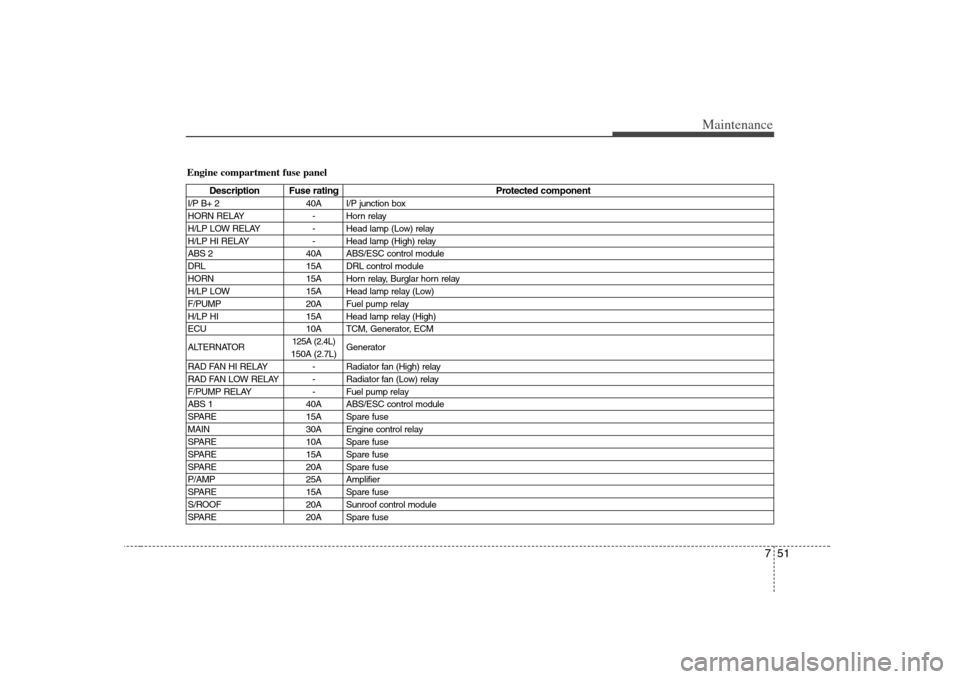
751
Maintenance
Engine compartment fuse panel
Description Fuse rating Protected component
I/P B+ 2 40A I/P junction box
HORN RELAY - Horn relay
H/LP LOW RELAY - Head lamp (Low) relay
H/LP HI RELAY - Head lamp (High) relay
ABS 2 40A ABS/ESC control module
DRL 15A DRL control module
HORN 15A Horn relay, Burglar horn relay
H/LP LOW 15A Head lamp relay (Low)
F/PUMP 20A Fuel pump relay
H/LP HI 15A Head lamp relay (High)
ECU 10A TCM, Generator, ECM
ALTERNATOR
125A (2.4L)
Generator
150A (2.7L)
RAD FAN HI RELAY - Radiator fan (High) relay
RAD FAN LOW RELAY - Radiator fan (Low) relay
F/PUMP RELAY - Fuel pump relay
ABS 1 40A ABS/ESC control module
SPARE 15A Spare fuse
MAIN 30A Engine control relay
SPARE 10A Spare fuse
SPARE 15A Spare fuse
SPARE 20A Spare fuse
P/AMP 25A Amplifier
SPARE 15A Spare fuse
S/ROOF 20A Sunroof control module
SPARE 20A Spare fuse
Page 321 of 341
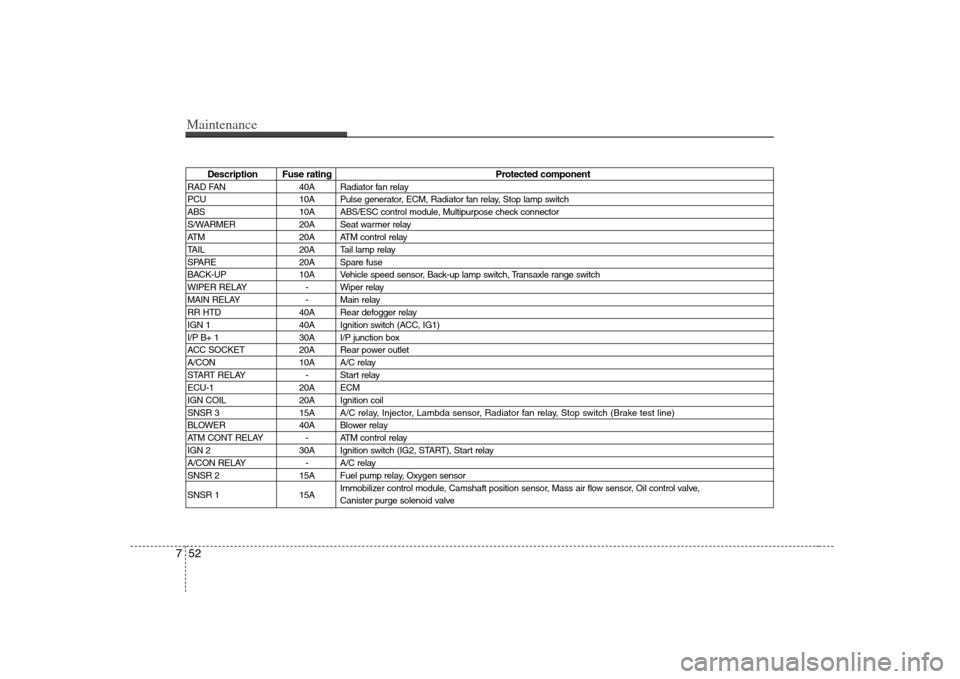
Maintenance52 7
Description Fuse rating Protected component
RAD FAN 40A Radiator fan relay
PCU 10A Pulse generator, ECM, Radiator fan relay, Stop lamp switch
ABS 10A ABS/ESC control module, Multipurpose check connector
S/WARMER 20A Seat warmer relay
ATM 20A ATM control relay
TAIL 20A Tail lamp relay
SPARE 20A Spare fuse
BACK-UP 10A Vehicle speed sensor, Back-up lamp switch, Transaxle range switch
WIPER RELAY - Wiper relay
MAIN RELAY - Main relay
RR HTD 40A Rear defogger relay
IGN 1 40A Ignition switch (ACC, IG1)
I/P B+ 1 30A I/P junction box
ACC SOCKET 20A Rear power outlet
A/CON 10A A/C relay
START RELAY - Start relay
ECU-1 20A ECM
IGN COIL 20A Ignition coil
SNSR 3 15AA/C relay, Injector, Lambda sensor, Radiator fan relay, Stop switch (Brake test line)
BLOWER 40A Blower relay
ATM CONT RELAY - ATM control relay
IGN 2 30A Ignition switch (IG2, START), Start relay
A/CON RELAY - A/C relay
SNSR 2 15A Fuel pump relay, Oxygen sensor
SNSR 1 15AImmobilizer control module, Camshaft position sensor, Mass air flow sensor, Oil control valve,
Canister purge solenoid valve
Page 324 of 341
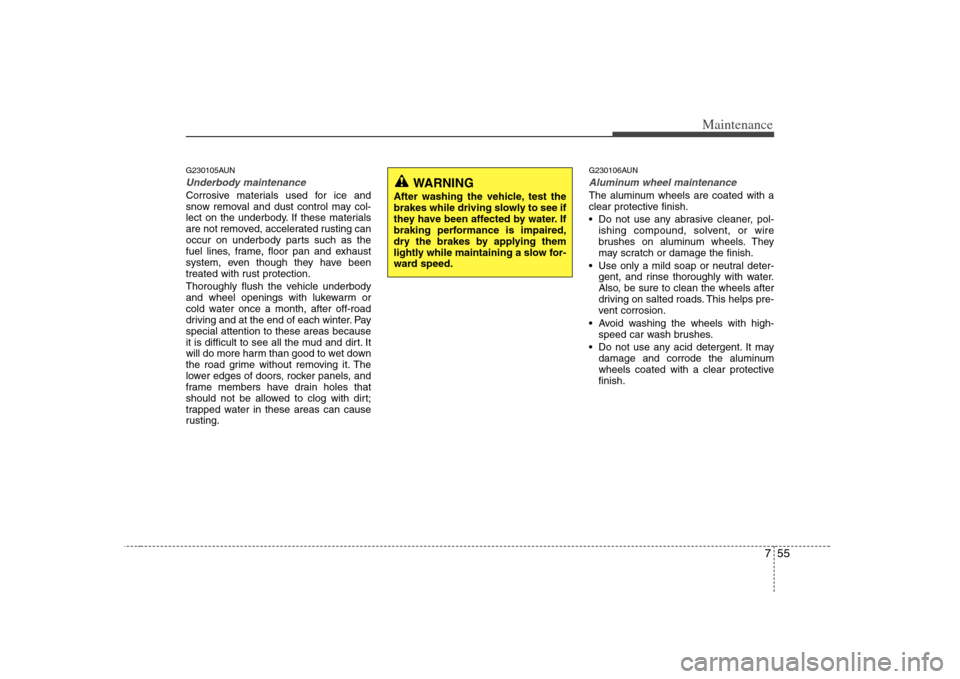
755
Maintenance
G230105AUNUnderbody maintenanceCorrosive materials used for ice and
snow removal and dust control may col-
lect on the underbody. If these materials
are not removed, accelerated rusting can
occur on underbody parts such as the
fuel lines, frame, floor pan and exhaust
system, even though they have been
treated with rust protection.
Thoroughly flush the vehicle underbody
and wheel openings with lukewarm or
cold water once a month, after off-road
driving and at the end of each winter. Pay
special attention to these areas because
it is difficult to see all the mud and dirt. It
will do more harm than good to wet down
the road grime without removing it. The
lower edges of doors, rocker panels, and
frame members have drain holes that
should not be allowed to clog with dirt;
trapped water in these areas can cause
rusting.
G230106AUNAluminum wheel maintenance The aluminum wheels are coated with a
clear protective finish.
Do not use any abrasive cleaner, pol-
ishing compound, solvent, or wire
brushes on aluminum wheels. They
may scratch or damage the finish.
Use only a mild soap or neutral deter-
gent, and rinse thoroughly with water.
Also, be sure to clean the wheels after
driving on salted roads. This helps pre-
vent corrosion.
Avoid washing the wheels with high-
speed car wash brushes.
Do not use any acid detergent. It may
damage and corrode the aluminum
wheels coated with a clear protective
finish.
WARNING
After washing the vehicle, test the
brakes while driving slowly to see if
they have been affected by water. If
braking performance is impaired,
dry the brakes by applying them
lightly while maintaining a slow for-
ward speed.
Page 328 of 341
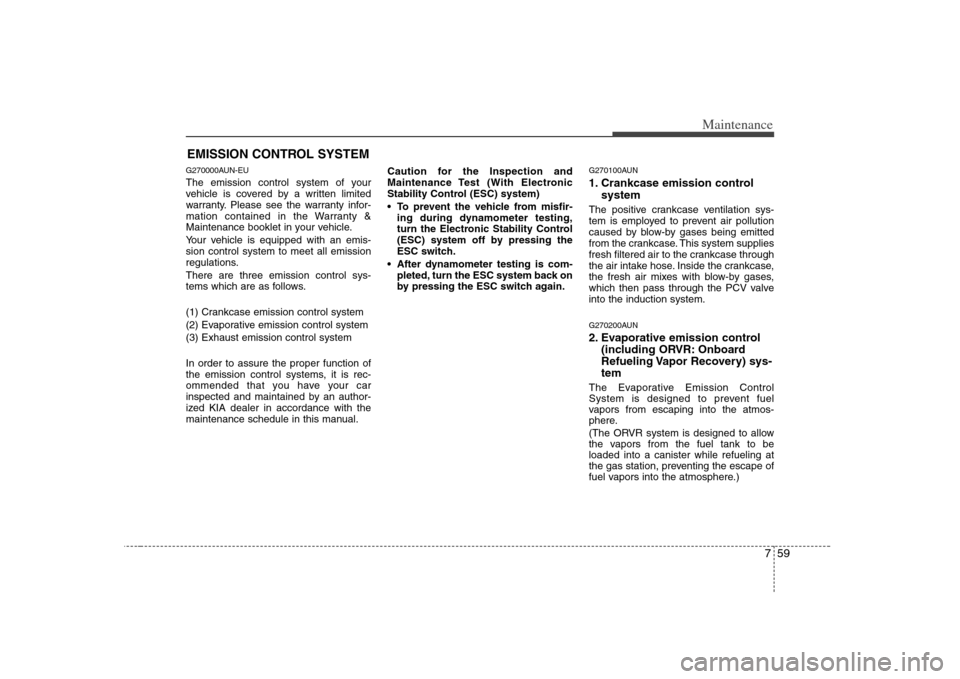
759
Maintenance
EMISSION CONTROL SYSTEMG270000AUN-EUThe emission control system of your
vehicle is covered by a written limited
warranty. Please see the warranty infor-
mation contained in the Warranty &
Maintenance booklet in your vehicle.
Your vehicle is equipped with an emis-
sion control system to meet all emission
regulations.
There are three emission control sys-
tems which are as follows.
(1) Crankcase emission control system
(2) Evaporative emission control system
(3) Exhaust emission control system
In order to assure the proper function of
the emission control systems, it is rec-
ommended that you have your car
inspected and maintained by an author-
ized KIA dealer in accordance with the
maintenance schedule in this manual.Caution for the Inspection and
Maintenance Test (With Electronic
Stability Control (ESC) system)
To prevent the vehicle from misfir-
ing during dynamometer testing,
turn the Electronic Stability Control
(ESC) system off by pressing the
ESC switch.
After dynamometer testing is com-
pleted, turn the ESC system back on
by pressing the ESC switch again.
G270100AUN1. Crankcase emission control
systemThe positive crankcase ventilation sys-
tem is employed to prevent air pollution
caused by blow-by gases being emitted
from the crankcase. This system supplies
fresh filtered air to the crankcase through
the air intake hose. Inside the crankcase,
the fresh air mixes with blow-by gases,
which then pass through the PCV valve
into the induction system.G270200AUN2. Evaporative emission control
(including ORVR: Onboard
Refueling Vapor Recovery) sys-
temThe Evaporative Emission Control
System is designed to prevent fuel
vapors from escaping into the atmos-
phere.
(The ORVR system is designed to allow
the vapors from the fuel tank to be
loaded into a canister while refueling at
the gas station, preventing the escape of
fuel vapors into the atmosphere.)
Page 329 of 341
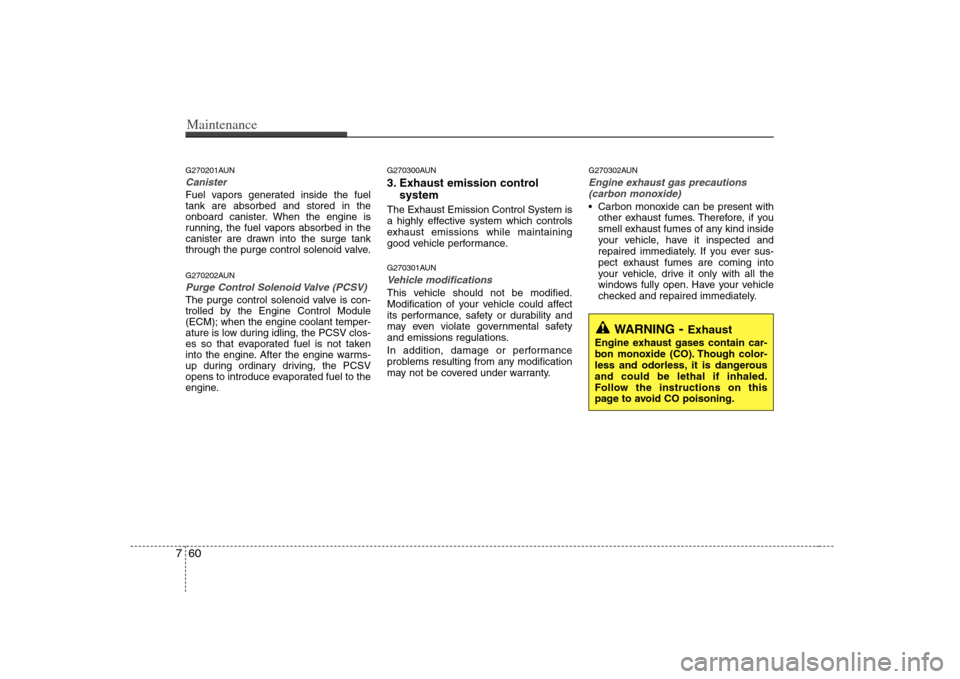
Maintenance60 7G270201AUNCanisterFuel vapors generated inside the fuel
tank are absorbed and stored in the
onboard canister. When the engine is
running, the fuel vapors absorbed in the
canister are drawn into the surge tank
through the purge control solenoid valve.G270202AUNPurge Control Solenoid Valve (PCSV)The purge control solenoid valve is con-
trolled by the Engine Control Module
(ECM); when the engine coolant temper-
ature is low during idling, the PCSV clos-
es so that evaporated fuel is not taken
into the engine. After the engine warms-
up during ordinary driving, the PCSV
opens to introduce evaporated fuel to the
engine.
G270300AUN3. Exhaust emission control
systemThe Exhaust Emission Control System is
a highly effective system which controls
exhaust emissions while maintaining
good vehicle performance.G270301AUNVehicle modifications This vehicle should not be modified.
Modification of your vehicle could affect
its performance, safety or durability and
may even violate governmental safety
and emissions regulations.
In addition, damage or performance
problems resulting from any modification
may not be covered under warranty.
G270302AUNEngine exhaust gas precautions
(carbon monoxide) Carbon monoxide can be present with
other exhaust fumes. Therefore, if you
smell exhaust fumes of any kind inside
your vehicle, have it inspected and
repaired immediately. If you ever sus-
pect exhaust fumes are coming into
your vehicle, drive it only with all the
windows fully open. Have your vehicle
checked and repaired immediately.
WARNING
- Exhaust
Engine exhaust gases contain car-
bon monoxide (CO). Though color-
less and odorless, it is dangerous
and could be lethal if inhaled.
Follow the instructions on this
page to avoid CO poisoning.
Page 330 of 341
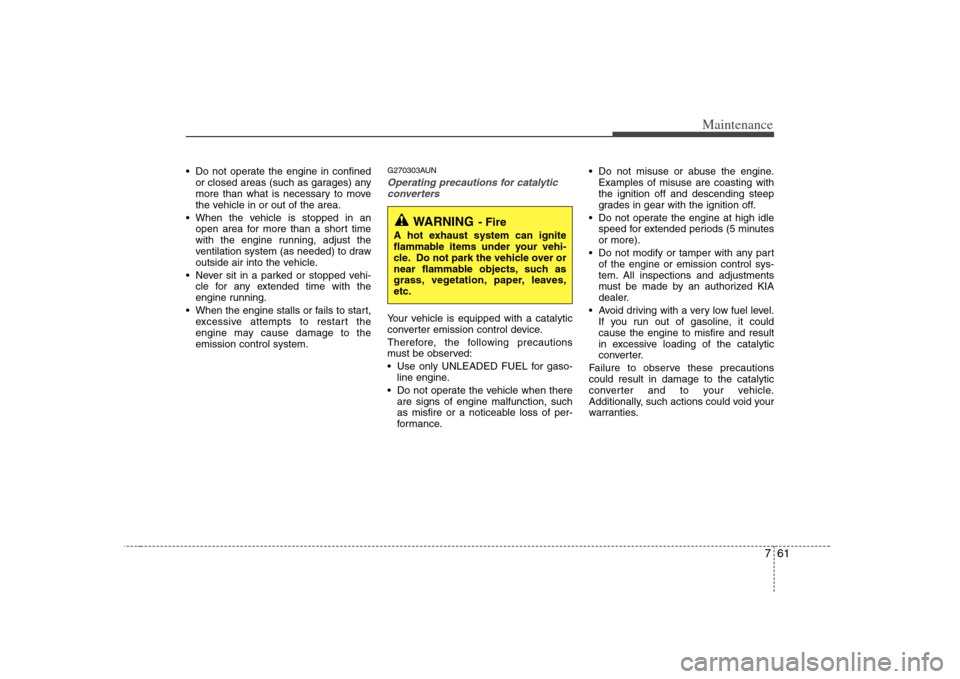
761
Maintenance
Do not operate the engine in confined
or closed areas (such as garages) any
more than what is necessary to move
the vehicle in or out of the area.
When the vehicle is stopped in an
open area for more than a short time
with the engine running, adjust the
ventilation system (as needed) to draw
outside air into the vehicle.
Never sit in a parked or stopped vehi-
cle for any extended time with the
engine running.
When the engine stalls or fails to start,
excessive attempts to restart the
engine may cause damage to the
emission control system.
G270303AUNOperating precautions for catalytic
converters Your vehicle is equipped with a catalytic
converter emission control device.
Therefore, the following precautions
must be observed:
Use only UNLEADED FUEL for gaso-
line engine.
Do not operate the vehicle when there
are signs of engine malfunction, such
as misfire or a noticeable loss of per-
formance. Do not misuse or abuse the engine.
Examples of misuse are coasting with
the ignition off and descending steep
grades in gear with the ignition off.
Do not operate the engine at high idle
speed for extended periods (5 minutes
or more).
Do not modify or tamper with any part
of the engine or emission control sys-
tem. All inspections and adjustments
must be made by an authorized KIA
dealer.
Avoid driving with a very low fuel level.
If you run out of gasoline, it could
cause the engine to misfire and result
in excessive loading of the catalytic
converter.
Failure to observe these precautions
could result in damage to the catalytic
converter and to your vehicle.
Additionally, such actions could void your
warranties.
WARNING
- Fire
A hot exhaust system can ignite
flammable items under your vehi-
cle. Do not park the vehicle over or
near flammable objects, such as
grass, vegetation, paper, leaves,
etc.
Page 334 of 341
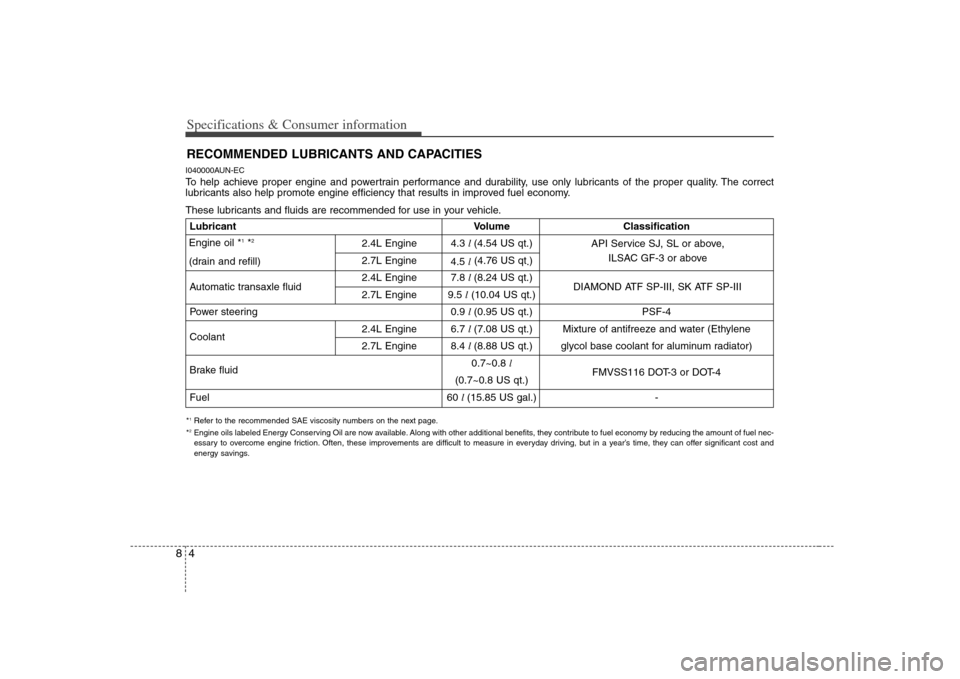
Specifications & Consumer information4 8RECOMMENDED LUBRICANTS AND CAPACITIES I040000AUN-ECTo help achieve proper engine and powertrain performance and durability, use only lubricants of the proper quality. The correct
lubricants also help promote engine efficiency that results in improved fuel economy.These lubricants and fluids are recommended for use in your vehicle.*1Refer to the recommended SAE viscosity numbers on the next page.
*2Engine oils labeled Energy Conserving Oil are now available. Along with other additional benefits, they contribute to fuel economy by reducing the amount of fuel nec-
essary to overcome engine friction. Often, these improvements are difficult to measure in everyday driving, but in a year’s time, they can offer significant cost and
energy savings.Lubricant Volume Classification
2.4L Engine 4.3 l (4.54 US qt.)
2.7L Engine
4.5 l(4.76 US qt
.)
2.4L Engine 7.8 l (8.24 US qt.)
Automatic transaxle fluid
2.7L Engine 9.5 l(10.04 US qt.)
Power steering 0.9 l (0.95 US qt.) PSF-4
Coolant2.4L Engine 6.7 l (7.08 US qt.) Mixture of antifreeze and water (Ethylene
2.7L Engine 8.4 l (8.88 US qt.) glycol base coolant for aluminum radiator)
Brake fluid0.7~0.8 l
(0.7~0.8 US qt.)FMVSS116 DOT-3 or DOT-4
Fuel 60 l (15.85 US gal.) -Engine oil *
1*2
(drain and refill)API Service SJ, SL or above,
ILSAC GF-3 or above
DIAMOND ATF SP-III, SK ATF SP-III
Page 335 of 341
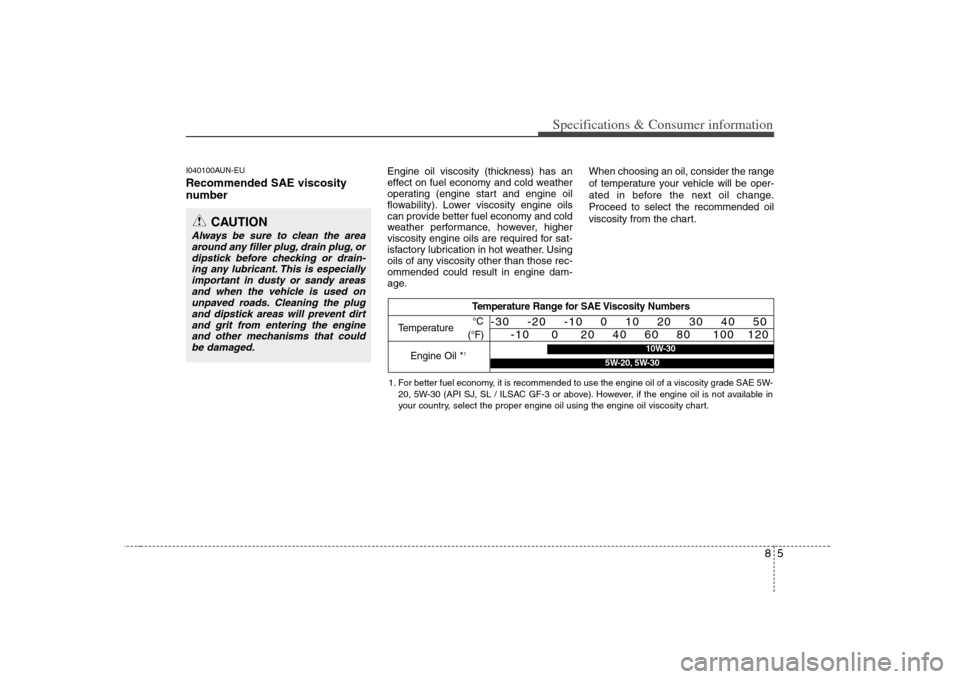
85
Specifications & Consumer information
I040100AUN-EURecommended SAE viscosity
number
Engine oil viscosity (thickness) has an
effect on fuel economy and cold weather
operating (engine start and engine oil
flowability). Lower viscosity engine oils
can provide better fuel economy and cold
weather performance, however, higher
viscosity engine oils are required for sat-
isfactory lubrication in hot weather. Using
oils of any viscosity other than those rec-
ommended could result in engine dam-
age.When choosing an oil, consider the range
of temperature your vehicle will be oper-
ated in before the next oil change.
Proceed to select the recommended oil
viscosity from the chart.
CAUTION
Always be sure to clean the area
around any filler plug, drain plug, or
dipstick before checking or drain-
ing any lubricant. This is especially
important in dusty or sandy areas
and when the vehicle is used on
unpaved roads. Cleaning the plug
and dipstick areas will prevent dirt
and grit from entering the engine
and other mechanisms that could
be damaged.
Temperature Range for SAE Viscosity Numbers
Temperature
Engine Oil *
1°C
(°F)
-30 -20 -10 0 10 20 30 40 50
-10 0 20 40 60 80 100 120
1. For better fuel economy, it is recommended to use the engine oil of a viscosity grade SAE 5W-
20, 5W-30 (API SJ, SL / ILSAC GF-3 or above). However, if the engine oil is not available in
your country, select the proper engine oil using the engine oil viscosity chart.
10W-30
5W-20, 5W-30
Page 339 of 341
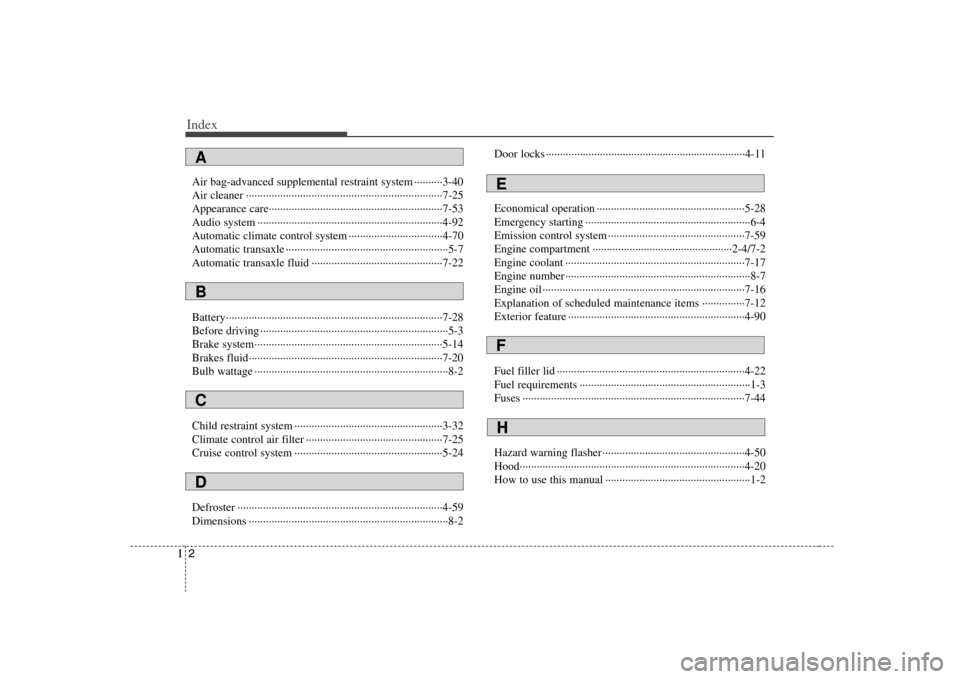
Index2I
Air bag-advanced supplemental restraint system ··········3-40
Air cleaner ·····································································7-25
Appearance care·····························································7-53
Audio system ·································································4-92
Automatic climate control system ·································4-70
Automatic transaxle ·························································5-7
Automatic transaxle fluid ··············································7-22
Battery············································································7-28
Before driving ··································································5-3
Brake system··································································5-14
Brakes fluid····································································7-20
Bulb wattage ····································································8-2
Child restraint system ····················································3-32
Climate control air filter ················································7-25
Cruise control system ····················································5-24
Defroster ········································································4-59
Dimensions ······································································8-2Door locks ······································································4-11
Economical operation ····················································5-28
Emergency starting ··························································6-4
Emission control system ················································7-59
Engine compartment ·················································2-4/7-2
Engine coolant ·······························································7-17
Engine number ·································································8-7
Engine oil ·······································································7-16
Explanation of scheduled maintenance items ···············7-12
Exterior feature ······························································4-90
Fuel filler lid ··································································4-22
Fuel requirements ····························································1-3
Fuses ··············································································7-44
Hazard warning flasher··················································4-50
Hood···············································································4-20
How to use this manual ···················································1-2ABCD
EFH